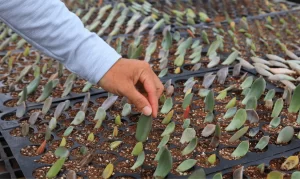How to Propagate Succulents? Complete Guideline: No one can deny that succulents are very eye-pleasing plants. It is a Xerophyte & one of the most beautiful plants of nature. This shallow-rooted plant can preserve water & can survive in the most difficult climates. Propagate succulents are not difficult, although the methods may differ depending on the genus and species of the succulent. But it is essential to know how to propagate succulents properly for the best outcome in your garden.
Contents
How to Propagate Succulents? Things To Know
If you want to propagate succulents yourself, you have to proceed differently depending on the genus and species, as we mentioned earlier. Different methods include propagation by seed, cuttings, or offshoots (filaments). The best time to do this is from spring to summer. Always use high-quality succulent soil or growing soil from a specialty store for propagating succulents. It is low in nutrients, structurally stable, and has a high water-holding capacity. Also, it is germ-free, which cannot be guaranteed if you make up a mixture yourself. The growing pots must also be as clean as possible.
Many succulents can be propagated by seed or cuttings. However, the easiest way is to grow offspring when succulents form so-called pups. It would help if you detached the offshoots from the plant, leave them to dry for a few hours, and then place them in a growing medium. Some easiest succulents to propagate are Sempervivum, Aloe vera, Kalanchoe, Burro’s Tail, etc.
How to Propagate Succulents by Sowing Seeds?
The duration of germination of individual seeds can vary greatly. We advise always using fresh seeds from the previous year when propagating succulents. Since not all succulents will fruit reliably when grown indoors, you can also use purchased seeds.
Begin sowing seeds in the spring, when light conditions improve and days become longer again. Spread the seeds in small jars and press them frivolously. Then add some sowing soil on top, just a little, and preferably in a sieved form. Place the pots in a semi-shaded location. The seeds of succulents should never dry out completely until germination. However, experience has shown that it is better not to water them from above but to place the pots in trays filled with water.
Succulents’ most favorable germination temperature is between 20 and 25 degrees Celsius (slightly cooler at night). They also require high humidity. To manage this, we recommend placing the pots in a mini-greenhouse or keeping them under foil. The only important thing is to ventilate daily and remove the cover as soon as the seeds germinate. That is how to propagate succulents by sowing seeds.
How to Propagate Succulents by Cuttings?
Many succulents can be propagated vegetatively by cuttings, including such popular species as the Christmas cactus (Schlumbergera) or the prickly pear (Opuntia). It is done by cutting off secondary shoots or individual leaves from the mother plant. Let’s have a look at how to grow succulents by cuttings.
Larger cuttings should be trimmed to a point at the cut. It will prevent the tissue from drying out too much, making rooting unnecessarily difficult. The procedure is somewhat different when propagating succulents with milky sap, such as various species of Euphorbia (spurge).
Learn more about How to Propagate Pothos?
First, it is essential to use gloves to protect yourself from the milky sap that escapes at the cuttings, some of which are toxic or at least irritating to the skin. Then the cuttings are dipped in water at 40 degrees Celsius to coagulate the sap before they are staked. As a general rule, succulent cuttings should be given some time to dry first. Cactus cuttings can even be kept dry until the first root beginnings appear. To do this, place them in a narrow container so that they do not touch the bottom. Then put them in pots with growing soil, where they usually root quickly in warm ambient temperatures. Do not water the plants, but only when roots have formed.
Foliage succulents such as Thickleaf (Crassula) or Flaming Cheetah (Kalanchoe) are propagated by leaf cuttings. Use only healthy and fully formed leaves that are not cut off, but broken or torn off by hand. Let them dry and stick them with the upper side of the leaves in the growing soil. And that is how to propagate succulents from stem cuttings.
Tip: Intersections make plants susceptible to disease. So, intersected places should be dusted with some charcoal powder.
How to Propagate Succulents Through Kindel?
If you want to know how to propagate succulents most easily, the answer is to form follicles. The botanist calls it secondary shoots that develop directly on the plant and are easily detached. Some even already have visible root attachments. Allow the offshoots to dry for a few hours before placing them in potting soil. That is usually all that is necessary. This type of propagation works with the aloe (bitter cap), the zebra haworthiya, or the sea urchin cactus (Echinopsis). The echeveria forms whole daughter rosettes, detached and planted separately.
Special Cases of Succulent Propagation
Of course, there are special cases among succulents that can be propagated in other ways. Living stones (Lithops), for example, can be divided during their growing season, which in the case of wayward plants means dividing the entire body into several pieces. Sprouting Mammillaria species can be propagated via warty cuttings, which the plants produce in large quantities. They are further cultivated, similar to seedlings.
Read more about How to repot a plant?
As soon as the succulents are well rooted and begin to sprout, they are pricked out into their pots and further cultivated as usual: The propagation is successful!
Conclusion: How to Propagate Succulents?
Propagation of succulents is not as difficult as we mentioned earlier. All you need to know is how to propagate succulents and take care of them properly. We have discussed the possible methods simply so you can easily follow the steps for propagating succulents. Please let us know through the comment section if you have any more queries.




